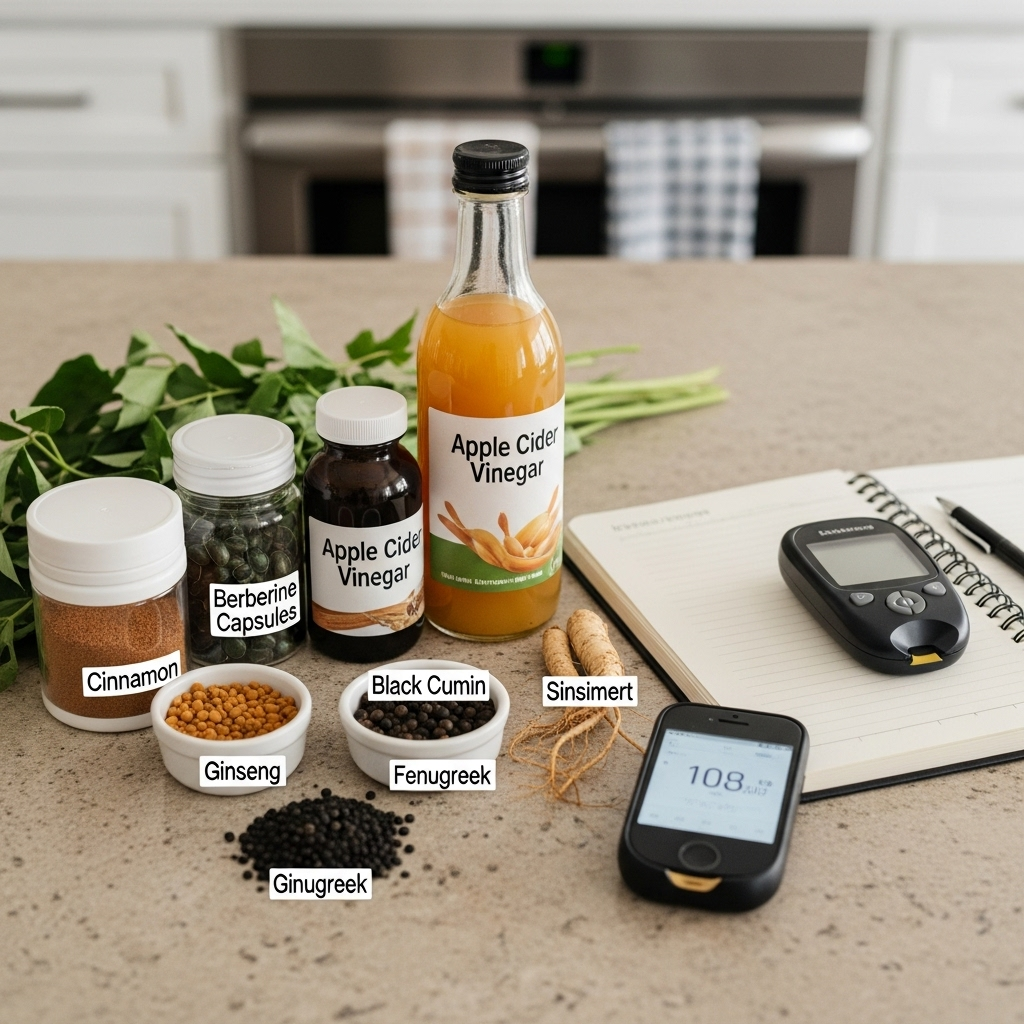As a passionate advocate for metabolic health, I often find that patients and readers are searching for additional tools to help manage their blood glucose levels. While the foundations of good metabolic health remain unchanged—proper nutrition, regular physical activity, quality sleep, and stress management—there are complementary approaches that may provide additional benefits.
Today, I'm exploring eight evidence-based natural strategies that show promise for supporting healthy blood sugar levels. These approaches aren't replacements for the fundamentals or medical treatment, but they may serve as valuable additions to your metabolic health toolkit.

The Importance of Complementary Approaches
Before diving into specific strategies, it's worth understanding why complementary approaches matter. Diabetes and metabolic dysfunction exist on a spectrum, and addressing these conditions often requires a multi-faceted approach.
The conventional medical system typically focuses on pharmacological interventions once problems have developed. While medications like metformin, GLP-1 agonists, and insulin have their place, they address symptoms rather than root causes. Additionally, they sometimes come with side effects that impact quality of life.
Complementary approaches can:
- Support the body's natural glucose regulation mechanisms
- Help reduce medication requirements (always under medical supervision)
- Address multiple aspects of metabolic health simultaneously
- Empower individuals to take active roles in their health journey
- Often provide benefits beyond just blood sugar control
Remember, the goal isn't to replace conventional treatment but to expand your toolkit for metabolic health.
Eight Natural Strategies with Scientific Support
1. Mind-Body Practices: Yoga, Qigong, and Tai Chi
These "meditative movement" practices combine physical activity, breathing techniques, and mindfulness—a powerful combination for metabolic health.
Research shows these practices can:
- Improve insulin sensitivity
- Reduce fasting glucose levels
- Lower HbA1c (a measure of long-term blood sugar)
- Decrease stress hormones that can raise blood sugar
One meta-analysis of 12 randomized controlled trials found that yoga significantly reduced fasting blood glucose and HbA1c in people with type 2 diabetes. The mechanisms likely involve both physical effects (improved muscle glucose uptake) and hormonal benefits (reduced cortisol and inflammation).

2. Meditation and Stress Reduction
Chronic stress triggers cortisol release, which increases blood glucose and promotes insulin resistance. Regular meditation practices can counteract this process.
Studies have demonstrated that consistent meditation can:
- Lower cortisol levels
- Reduce insulin resistance
- Improve glycemic control
- Decrease HbA1c in those with type 2 diabetes
Even 10-15 minutes daily of focused breathing or mindfulness meditation can yield benefits. This makes meditation one of the most accessible tools on this list.
3. Cinnamon: More Than Just a Spice
This common kitchen spice contains bioactive compounds that mimic insulin action and slow digestion. Research suggests consuming 1-6 grams daily (about 1/2 to 2 teaspoons) may:
- Improve insulin sensitivity
- Reduce fasting blood glucose
- Lower post-meal blood sugar spikes
- Improve lipid profiles
The type of cinnamon matters—Ceylon cinnamon (true cinnamon) is generally preferred over Cassia cinnamon, especially for long-term use, as Cassia contains higher levels of coumarin, which may be harmful in large amounts.
4. Berberine: The Promising Plant Compound
Berberine is a bioactive compound found in several plants including goldenseal, Oregon grape, and barberry. Its effects on blood glucose are so significant that it's sometimes called "nature's metformin."
Research shows berberine can:
- Lower fasting blood glucose
- Reduce HbA1c levels
- Improve insulin sensitivity
- Decrease inflammation
- Benefit cholesterol levels
Typical dosages in studies range from 500mg to 1500mg daily, divided into 2-3 doses. However, it can interact with certain medications, so medical supervision is essential.
5. Vinegar: Simple Yet Effective
The acetic acid in vinegar appears to slow gastric emptying and inhibit enzymes involved in carbohydrate digestion. This translates to more gradual glucose absorption and smaller post-meal spikes.
Studies have found:
- About 1-2 tablespoons of vinegar before or with carbohydrate-containing meals can reduce post-meal glucose elevations by approximately 20%
- Regular consumption may modestly improve insulin sensitivity
- Apple cider vinegar is most commonly studied, but other vinegars likely offer similar benefits
This is perhaps the most accessible intervention on this list—simply add vinegar to salad dressings or dilute a tablespoon in water before meals.
6. Nigella Sativa (Black Cumin): An Ancient Remedy
Used in traditional medicine for centuries, black cumin seeds and their oil show promising effects on glucose metabolism.
Research indicates that Nigella sativa may:
- Reduce fasting glucose
- Lower post-meal glucose elevations
- Decrease HbA1c
- Improve insulin resistance markers
Studies typically use 1-3 grams of powdered seeds or about 1-2.5 mL of oil daily. The active compound thymoquinone appears responsible for many of these benefits.
7. Fenugreek: The Dual-Acting Seed
Fenugreek contains soluble fiber and compounds that can both slow digestion and stimulate insulin release.
Clinical studies show fenugreek may:
- Lower fasting blood glucose
- Reduce post-meal glucose spikes
- Decrease HbA1c
- Improve insulin sensitivity
Typical dosages range from 5-50 grams of seeds or 1-2 grams of standardized extract daily. The seeds can be soaked, sprouted, or ground and added to meals.
8. Ginseng: The Adaptogenic Root
Several types of ginseng (American, Asian, Korean) contain ginsenosides that appear to enhance insulin secretion and glucose uptake into tissues.
Research demonstrates that ginseng may:
- Modestly lower fasting blood sugar
- Blunt post-meal glucose rises
- Improve insulin sensitivity
- Provide additional adaptogenic benefits for stress management
Studies typically use 1-3 grams of root powder or 200-400mg of extract daily. The type and preparation of ginseng may influence its effects.

Implementation: Start Small and Monitor
While these approaches show promise, implementing them requires thoughtfulness. Here's how to proceed:
-
Prioritize the foundations first: Ensure your nutrition, physical activity, sleep, and stress management are well-addressed before adding these complementary approaches.
-
Start with one intervention: Adding multiple supplements or practices simultaneously makes it impossible to determine what's working.
-
Monitor your response: Use a continuous glucose monitor (CGM) if possible, or regular blood glucose testing to observe effects.
-
Consult healthcare providers: Particularly important if you're taking medications, as some natural approaches may potentiate their effects, potentially causing hypoglycemia.
-
Be patient: Many of these approaches produce gradual improvements rather than dramatic overnight changes.
I find the mind-body practices (yoga, meditation) and simple dietary additions (vinegar, cinnamon) to be excellent starting points for most people due to their safety profile and additional health benefits beyond glucose control.
Remember that metabolic health is a journey, not a destination. These complementary approaches may provide additional support, but they work best when built upon the solid foundation of proper nutrition, regular physical activity, quality sleep, and stress management.
References
-
Chimkode SM, Kumaran SD, Kanhere VV, Shivanna R. Effect of yoga on blood glucose levels in patients with type 2 diabetes mellitus. J Clin Diagn Res. 2015;9(4):CC01-CC03.
-
Cicero AFG, Baggioni A. Berberine and Its Role in Chronic Disease Management. In: Watson RR, Preedy VR, eds. Bioactive Food as Dietary Interventions for Diabetes. 2nd ed. Academic Press; 2019:445-463.






